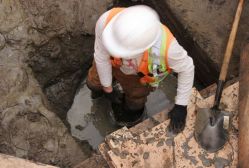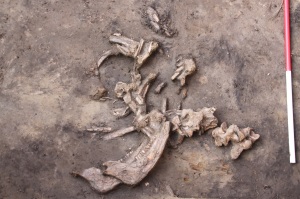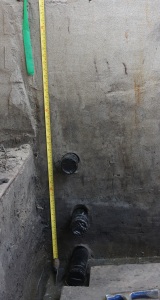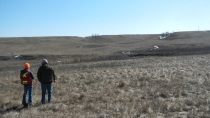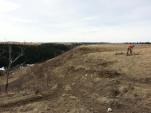I mentioned previously the surprise occupation located 185cm below the surface, it turned out to be a rather good occupation level with ample bones and artifacts. Our problems arose as we got a bit deeper into it and encountered the water table – unlucky for us there happens to be a high water table in the area. So, now we not only had to worry about creating shoring that would prevent us from being covered in sand at any given moment but also how to draw the water away from our active units.
In the end, our solution was sump pumps. We had four pumps running around the clock to keep the water low enough that we could excavate through the occupation level; we started this area at the end of winter and as spring thaw hit us we had to try and dig the pumps even deeper to keep on top of the water situation (we had to quickly, but still properly, excavate sump pump holes in areas of low artifact returns). We also discovered that water-logged sand is also rather prone to giving out suddenly – quite aggravating when you’re trying to keep the walls looking good for photographs, profile drawing and site visitors (no one wants to be accused of having sloppy walls, no one).
 We only recovered 5 projectile points from this occupation level – not great but not terrible. They’re a bit mysterious though, they don’t really fit with the type of points we were expecting to find at that depth. We were expecting thicker, chunkier points, but these ones are relatively thin and well-made. They look like they should be Late Period points but that doesn’t fit with the order of the occupations we have represented on our site. So, at the moment our best guess is that they are intermediate points from the transition of Early to Middle Prehistoric – which is exciting because that means they’re quite old indeed (7 – 9,000 years old).
We only recovered 5 projectile points from this occupation level – not great but not terrible. They’re a bit mysterious though, they don’t really fit with the type of points we were expecting to find at that depth. We were expecting thicker, chunkier points, but these ones are relatively thin and well-made. They look like they should be Late Period points but that doesn’t fit with the order of the occupations we have represented on our site. So, at the moment our best guess is that they are intermediate points from the transition of Early to Middle Prehistoric – which is exciting because that means they’re quite old indeed (7 – 9,000 years old).
Normally, we do radiocardon dating of the bone to back-up our estimation of the date based on the projectile points. Our sneaky low occupation had plenty of bone but the water table got one up on us this time. The bone looked fantastic as you exposed it from the damp, organic-rich sediment but as soon as you tried to remove it from the ground it would crumble into a pile of tiny fragments. Through much painstakingly slow work we managed to get some of the bone out in relatively one piece and sent it off to the labs in Florida.
Sadly, all our efforts were in vain. The constant movement of water in the area had leached all of the collagen out of the bones, leaving nothing for the lab to extract and test for us. We sent them almost 10 samples and each one came back with the same disappointing outcome. Not to be discouraged, we were set upon the idea of doing OSL (optically stimulated luminescence) dating. This method of dating involves taking samples of sand from deep within our profiles and using science-magic (ok it’s real science I just don’t know all the specifics of how it works) they analyze the last time the sand was exposed to sunlight.
Taking the samples took an afternoon, waiting for the lab in Scotland to get us some dates took about 5 months longer. Our preliminary look at the dates supports our Early to Middle transition deduction with the date range being 6780 – 8700 years BP. We still need to do some further analysis and make sure everything matches up like it should between all the records, but we’re excited and this is definitely the oldest Alberta site I’ve worked on thus far.

